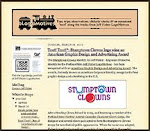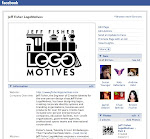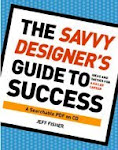bizzed uncovers the success secrets behind this design extraordinaire:, the financial obstacles he overcame and advice for other entrepreneurs.
By Maria DiBenedetto
"It's not that I don't play well with others; it's just that I want to choose where, when and with whom I play." - Jeff Fisher comments on turning his dream business into a reality.
 Since 1995, Jeff Fisher's work has won over 300 design awards and appears in nearly 50 books on graphics, logo design and small business marketing. So, just how exactly did this artist with a good business idea turn a $2000 loan from his grandparents and income from part-time jobs into a successful small business that has stood the test of time? (Jeff has been running his own business for nearly twenty years).
Since 1995, Jeff Fisher's work has won over 300 design awards and appears in nearly 50 books on graphics, logo design and small business marketing. So, just how exactly did this artist with a good business idea turn a $2000 loan from his grandparents and income from part-time jobs into a successful small business that has stood the test of time? (Jeff has been running his own business for nearly twenty years).
"I think I have become what I wanted to be when I grow up," says Jeff. "I wanted to be working for an internationally recognized, award-winning design firm - instead I have become one," he adds proudly. Today, Jeff Fisher LogoMotives is a successful home-based design firm in Portland Oregon, with clients throughout the United Staes and around the world.
THE INTERNET OPENED UP A NEW FRONTIER FOR JEFF'S BUSINESS
In November of 1999, Jeff's web site went live - and a whole new world opened up to him. He seamlessly began to reach and obtain clients throughout the United States and foreign countries - many of whom he has never even met personally
"What has taken place with the Internet is my ability to work from whereever I may be at the time - be it a mountaintop, a hotel room, or the beach," he adds, commenting on the increased flexibility and life balance it has afforded him.
"The Internet has been an incredible tool for doing what is necessary to do to make the new business real. Whether it's networking with others in the same situation, researching business sites, checking out the competition or getting information from the Small Business Administration; it's all at your fingertips through the Internet," he explains.
HIS INITIAL FUNDING
For the most part, the initial funding for Jeff's graphic design came out of working part-time jobs. When he first moved to Portland, he worked part-time in a picture frame shop. He had worked in restaurants, art galleries, and retail, so he knew he would always have something to fall back on if absolutely necessary.
Early on, Jeff's grandparents helped out by loaning him a small sum of money for his business venture. "It also helps to have a supportive partner in life, who can help play the 'musical money' game when required," he adds. "A bank would have laughed me out of their office at the time."
When Jeff started his business in 1980 right out of college, he literally had nothing. "This was pre-personal computers, and in fact, I had never even seen a computer."
For nearly the first ten years of his business all work was done by hand. All original art work was drawn with a rapidiograph ink pen. All ads, brochures, newsletters, magazines were produced in the old "cut and paste" method.
The expenses came later with the need for a computer, software, a printer and all the other items required to technically run a design office. Then, of course, he needed to upgrade equipment on a regular basis.
He now owns: a large desktop system, a color laser printer, a work-horse black and white laser printer, a color inkjet printer, a laptop computer, a portable color ink-jet printer, a CD burner, a fax machine/copier and more. "In equipment alone I probably made a $35,000 - $45,000 investment. I also own a library of over 200 design books and mannuals - the same books I could never afford as a student!"
A WINDING ROAD: OVERCOMING HURDLES TO PURSUE HIS PASSION
Jeff's desire to study graphic design in college was not met with enthusiasm. "I don't know how many times I heard, 'You will never be able to make a living as a designer or an artist," he adds.
During the course of his first year at the University of Oregon, he began to feel as if all the naysayers were right. "I hated the graphic design program and was ready to quit school," he adds.
A friend in the advertising program suggested Jeff speak to one of the professors in the Journalism School. "However, I would be required to take all the required journalism coursework to be able to take the design courses I wanted," says Jeff. The investment paid off for Jeff. The classes he took in typography, public relations, marketing, journalistic writing and advertising would make him much more successful as a designer later in his career.
While at the University of Oregon, he got a part-time job as the graphic designer for the advertising department of the daily college newspaper, The Oregon Daily Emerald. With that position, his career in design began...
THE EARLY YEARS: A PRELUDE TO ENTRPRENEURSHIP
"I think I have always had the entrepreneurial spirit," says Jeff. "As a young boy I can remember picking the blossoms off my mother's favorite roses and, with the help of my sister and brothers, mashing them in water, bottling it as perfume and selling it to our neighbors," he adds. At the time, he didn't realize he would be successful years later in a different creative field.
Jeff's interest in design and art began as far back as grade school in Salem, Oregon. By the time he had graduated from high school he'd exhibited his artwork in several galleries, won several art awards and had three one-man shows of his work.
When he moved to Portland, Oregon in the fall of 1980 he had no intention to work for himself. "Thinking I was pretty hot stuff, I assumed I would be working for one of the major advertising firms in the city," admits Jeff. Unfortunately, the recession arrived in Portland the same week, and Jeff couldn't find a job.
THE POWER OF NETWORKING
However, that did not stop him from talking to any advertising person who would open their door to him. "I never asked people if they had a job for me when requesting time with them. I asked if they would talk to me about advertising as a career and their experiences in the field. People love to talk about themselves." Soon these same people were calling him with freelance design projects and giving his name to other potential clients. "By accident, I had started my own design firm."
TURNING THE DREAM INTO A REALITY
"In junior high, high school and college I actually would dream of being a 'famous' graphic designer. I would go to libraries or bookstores and thumb through design books dreaming of the day my work would appear for all to see." At that time, he couldn't even afford the books - now he owns an entire graphic design library.
HOW DID JEFF GET HIS "BIG BREAK"?
It seems as if his "big break" took about 15 years to arrive. "For those 15 years I took on any and every design project that came my way. I was busy, and making a living, but not always thrilled with the projects. I was the most happy with my work when designing logos," he adds.
Still, he began to do more and more logo design. His sister, Sue Fisher, had opened a public relations and advertising firm in Bend, Oregon and began to send logo design projects his way.
Jeff decided to add "Jeff Fisher" to the business name "LogoMotives." With this company name change, he could convey his reputation of more than 15 years and tell potential clients what he actually designed. The result was almost immediate in more identity projects coming his way. "With more exposure to the name Jeff Fisher LogoMotives clients began to seek me out and I had to do less searching for work," he adds.
WHAT'S IN A NAME...
With the focus on what he enjoyed doing most - his work also improved a great deal. Major clients, with projects other than logo design, began to contact me including: The Portland Trail Blazers, The Seattle Seahawks and others big names.
In changing the focus of his business to logo design, he took on a new attitude about his work and began to accept it as a REAL business. "For years, I had told people I was a freelance designer and the reaction was not always positive. The term "freelance" also implied that my work had less value than that of a person in a traditional employment position," explains Jeff. "When I started treating myself more like a business others did as well," he adds.
REVISING HIS MARKETING STRATEGY
Jeff also changed his strategy in marketing his business. He no longer participated in print advertising or direct mail promotions. Instead, Jeff shifted that budget to the entry fees required to enter international and national graphic design competitions. The results came quickly. To date, he has won over 300 design awards for his logos. Many such competitions result in design books or annuals being published. "You would be amazed at the number of potential clients contacting me after seeing my work in various design books, while flipping through them at their local book store," he adds.
WHAT SORT OF HR OR HIRING TIPS DOES JEFF HAVE FOR OTHER PEOPLE STARTING-UP?
"Being able to let go of various aspects of your business where you can really use help is probably the most difficult thing to do," he says. He suggests that anyone considering starting their own business determine what they most want to be doing in the venture - and what they do not want to do.
"I do not like tracking the finances of my business and I do not do it." His partner and his accountant (who has lots of experience with "creative types") have trained him to sort all receipts and other financial items into pre-prepared envelopes each year. Then, they take care of the paperwork. "I know it will get done properly and I don't have to become a neurotic mess dealing with it," he adds.
JEFF'S ADVICE FOR SOMEONE LOOKING TO START A BUSINESS?
Jeff's best piece of advice is to find a business that involves doing something you truly enjoy doing on a regular basis. "Don't just start a business just because you see a need for it in a certain location or at a certain time. You must have a passion for the business - especially since it will consume you and your life at times," he adds.
So often people are not open to the opportunities right before them when it comes to stating their own business. "I think I was guilty of that in not focusing on logo and corporate identity design much sooner," says Jeff. Many people overlook the skills, passion, and knowledge within them-selves when considering a new venture. "It may require stepping away from the project a bit, getting the advice of friends about your ideas or what they see as your strong points, and talking to people in business so you don't necessarily have the same difficulties they may have had along the way," he adds.
MAKING IT HAPPEN
"Do the research and leg work," says Jeff. As someone who works with many people starting new businesses, he notices a smarter and more realistic entrepreneur in today's economy. "People are not doing the old Mickey Rooney/Judy Garland 'let's put on a show' routine and immediately opening a new business." Lately he's had numerous clients come to him to start the design process on their business identity a year or 18 months prior to their scheduled business opening. "They are carefully researching all aspects of the business, allowing a reasonable amount of time for all tasks associated with opening the new business," he notes
JEFF'S SUCCESS MANTRA
His friends and clients would probably agree that his mantra actually is to work less and charge higher fees! "The odd thing is that each time I have raised my rates - I get more potential clients and end up working more. There is the perception that if it cost more it must be good, or better," he explains.
Meanwhile, Jeff has built a home-based business that affords him the freedom to pave his own way. "It's not that I don't play well with others; it's just that I want to choose where, when and with whom I play." That was a goal early on in his career and it becomes more real every day.
This article, written by Maria DiBenedetto, was originally posted on Citibank's www.bizzed.com in March 2001
© 2007 Jeff Fisher LogoMotives






